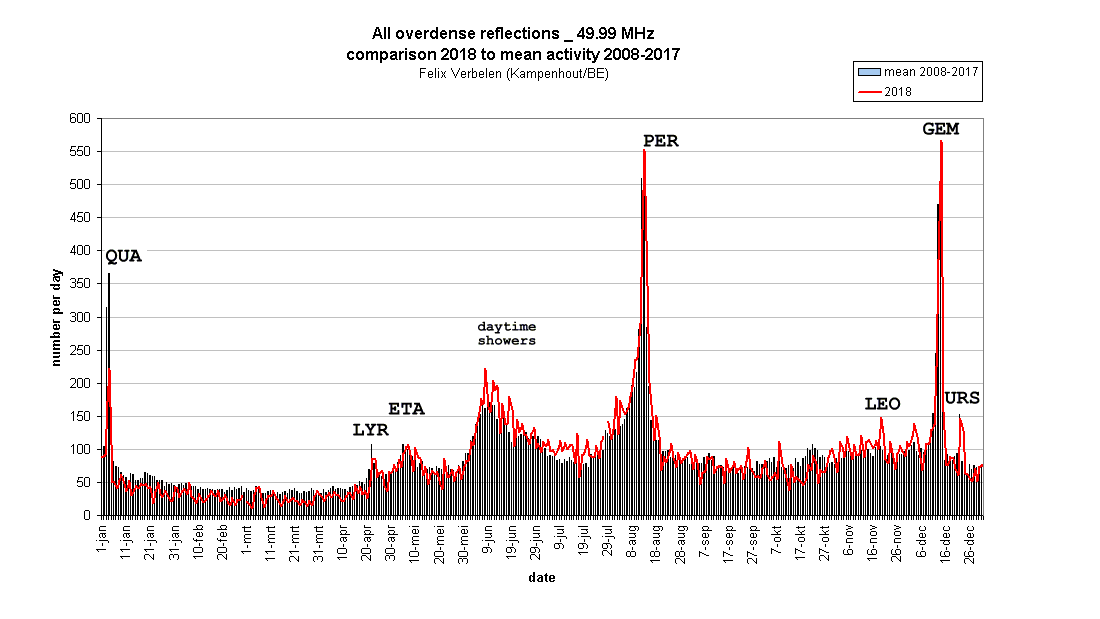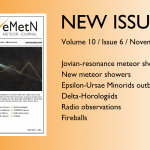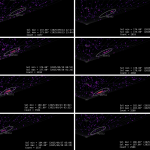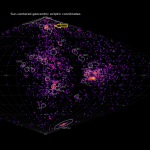The annual report is presented with the results of the radio observations in 2018, with the relative activity of meteor showers in three categories of all overdense duration. The 2018 activity is compared with the average activity 2008-2017.
1 Introduction
The observations were carried out here at Kampenhout (BE) on 49.99 MHz, the frequency of our VVS beacon that is hosted by the colleagues of AstroLab-IRIS at Zillebeke (Ypres/BE). This beacon has been active since April 2005. Permanent monitoring of the forward scatter observed at Kampenhout started at the same time.
Both the beacon and the receiving installation remained practically unchanged for the entire period until now, and fortunately suffered only minimal problems or interruptions.
The activity graphs show only the number of overdense reflections, subdivided into 3 categories: “all overdense reflections“, “all overdense reflections lasting more than 10 seconds“, “all overdense reflections longer than 1 minute“. Counts were all done manually, based on 5 minutes screen dumps obtained with the excellent program “SpecLab”.
The presented charts indicate respectively:
- a global annual overview for each of the 3 categories showing the relative importance of the meteor shower in each category (Figure 1).
- a similar overview, but then per trimester (Figures 2, 3, 4 and 5).
2 The major meteor showers in 2018
Comparison of the three categories gives a good indication of the composition of the different meteor showers. It is i.e. striking that the Quadrantids (QUA) (Figure 2) and the Geminids (GEM) (Figure 5), that yield, as we know, a lot of reflections and are therefore considered, together with the Perseids (Figure 4), as the main annual showers, show little or no reflections with a duration of more than 1 minute.
3 Comparing 2018 activity with 2008-2017
Comparing 2018 to the 10-year average of the period 2008-2017, 2018 was a fairly normal meteor year, with the following exceptions:
- the Quadrantids (QUA) were much less active than average in the three considered categories (Figure 2);
- the Lyrids (LYR) were also less active than in previous years (Figure 3);
- the surprise of the year were the Leonids (LEO), producing an unusual number of long lasting reflections (Figure 5);
- the Ursids (URS) were less active than on some previous occasions (Figure 5).
The activity of the other “big” showers (i.e. Eta Aquariids, daytime showers including the Arietids, Perseids, Draconids, Orionids) was pretty well in line with the 10-year average.
Smaller and weaker showers showed some variations in 2018 compared to their average activity, but these should be further investigated on the basis of the hourly averages and certainly also taking into account the “underdense” reflections.

Figure 1 – Global annual overview for each of the 3 categories: “all overdense reflections”, “all overdense reflections lasting more than 10 seconds”, “all overdense reflections longer than 1 minute”. This shows the relative importance of the meteor shower in each category. The daily meteor activity in 2018 is compared
to the average daily activity during the period 2008-2017.

Figure 2 – First quarter 2018 overview for each of the 3 categories: “all overdense reflections”, “all overdense reflections lasting more than 10 seconds”, “all overdense reflections longer than 1 minute”. This shows the relative importance of the meteor shower in each category. The daily meteor activity in 2018 is compared to the average daily activity during the period 2008-2017.

Figure 3 – Second quarter 2018 overview for each of the 3 categories: “all overdense reflections”, “all overdense reflections lasting more than 10 seconds”, “all overdense reflections longer than 1 minute”. This shows the relative importance of the meteor shower in each category. The daily meteor activity in 2018 is compared to the average daily activity during the period 2008-2017.

Figure 4 – Last quarter 2018 overview for each of the 3 categories: “all overdense reflections”, “all overdense reflections lasting more than 10 seconds”, “all overdense reflections longer than 1 minute”. This shows the relative importance of the meteor shower in each category. The daily meteor activity in 2018 is compared to the average daily activity during the period 2008-2017.

Figure 5 – Third quarter 2018 overview for each of the 3 categories: “all overdense reflections”, “all overdense reflections lasting more than 10 seconds”, “all overdense reflections longer than 1 minute”. This shows the relative importance of the meteor shower in each category. The daily meteor activity in 2018 is compared to the average daily activity during the period 2008-2017.





